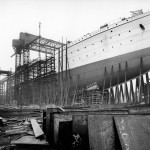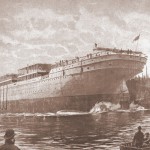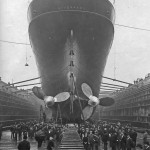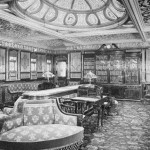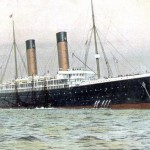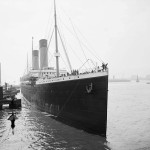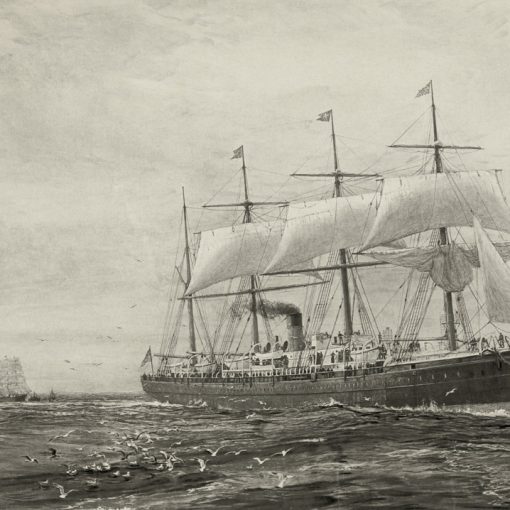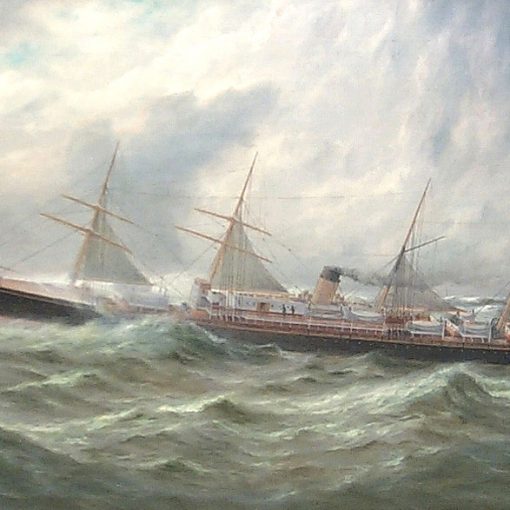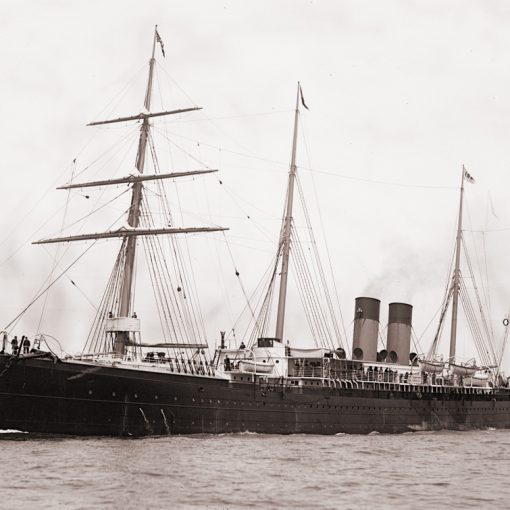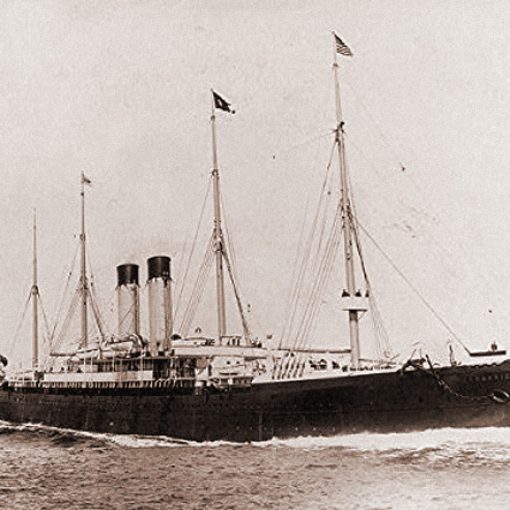1899 – 1914
By 1890, the largest ship ever constructed in history was the Great Eastern from 1859. Since this vessel had gone to the scrapyards in 1888, and no other ship had been near the Great Eastern’s size, it was time to update ships so that they succeeded the Great Eastern. That was what Thomas Henry Ismay thought when he commissioned a new pair of ships from Harland and Wolff’s shipyard. They were supposed to be Oceanic and Olympic. With a length of over 700 feet these new ships would surpass the Great Eastern’s old record of 689 feet rather easily. Of course the tonnage of Great Eastern remained a record, for the White Star Lines new duo would only have a gross tonnage of slightly over 17,000 tons compared to the Great Eastern’s near 19,000. This would make the new ships the largest in existence, but not the largest in history.
As the White Star Line’s policy more and more turned out to be, speed was not the main part about the new ships. The service speed would not exceed White Star’s former Blue Riband-holders Teutonic’s and Majestic’s 20+ knot speed, but would still manage to hold some 19-20 knots during an entire voyage as service speed.
On January 14, 1899, the first of the class; the Oceanic was launched. No one had seen such a great ship since the disappearance of the Great Eastern in 1888. With two huge funnels painted in the White Star Line’s company colour buff, raised forecastle and poop deck and the clean lines typically for White Star ships, she was quite a beautiful sight. The name decided upon was that of the White Star Line’s pioneer vessel. It was considered good luck to name a new ship after an old reliable one, and the second Oceanic was to be the pride of her company. On August 26, she had finished her satisfactory sea trials and left Belfast for Liverpool. In Liverpool she would be opened up for the press, as customary with a new ship. When the media had been satisfied, the ship was prepared for her maiden voyage. After almost a week all was finished and the Oceanic left Liverpool for the Americas. The voyage went off without any mishaps and six days, two hours and thirty-seven minutes after the beginning of her premiere trip Oceanic entered the harbour of New York. She had averaged 19.57 knots, which was perfectly adequate. One problem was discovered however, and that was that the stern of the ship vibrated violently at full power.
The new Oceanic continued her service and held the title of the largest ship in the world throughout the century. On the first year of the new century, when anchored in the Mersey, the Oceanic was struck by lightning and lost the top of her main mast. In April, 1901, the Oceanic was not any longer the largest ship in the world. The White Star Line then launched the Celtic at 21,000 tons. The Celtic was the first ship to surpass the Great Eastern in tonnage as well as length. The same year was to become somewhat sad for the Oceanic in another way as well. In September she accidentally rammed and sank the small Waterford S.S. Co. steamer Kincora in heavy fog just outside Tuskar Rock. Seven people perished as a result of the collision.
Ever since her launch, the Oceanic had patiently waited for her sister, the Olympic, to be born. But after Thomas Ismay had died in 1899, the order was cancelled. This was in order to gather strength to produce what was to be called the ‘Big Four’ class (Celtic, Cedric, Baltic and Adriatic), all over 20,000 tons.
In the old days, before equality laws and high labour salaries with working conditions unimaginable for us today, the working class was often looked down upon. This went too far on board the Oceanic one day in 1905. Some of the ship’s stokers carried through a mutiny against the commanding officers. As one could expect thirty-five of these stokers were punished and charged later with order restored.
In 1907, the White Star Line changed their main homeport to Southampton, and on May 22, that year Oceanic made her last sailing from Liverpool. The first departure from her new homeport was done twenty-eight days later. Her running mates on the Southampton-New York run were the Teutonic, Majestic and the new Adriatic.
In 1914, war was declared between Britain and Germany, and the Admiralty required merchant vessels to participate in the hostilities. The Oceanic, who had made her last voyage to New York in July, was commissioned as an ‘Armed Merchant Cruiser’. The Admiralty, with no experience in handling such large ships as the Oceanic, appointed the Royal Naval Captain W. F. Slayter to command the ship. As some sort of precaution, Oceanic’s own captain Henry Smith was present on the ship. To have an inexperienced captain proved to be foolish. On September 8, when the Oceanic was three miles off Foula Island (twenty miles west of the Shetland Islands) Captain Smith told Captain Slayter that he had moved the ship too close to land, when trying to pass the island, and was risking to ground her as the current was moving rapidly. Captain Smith was overruled by the naval captain, who insisted on a tight schedule. As a result, the ship was taken off course by Mother Nature and grounded on the Hoevdi Rocks in the Shaalds. Since the people on board the Oceanic were stuck on the ship, help was called for and the small trawler Glenogil came to assist and transferred some 400 men to other ships now present. Attempts to pull the ship off the rocks failed, and two weeks later the sea began to handle the Oceanic badly. She was declared a total loss, and all salvage thoughts were abandoned. No one of the two captains was blamed, but D. Blair, the ship’s navigator, was held responsible for the sad event. After this accident, the Admiralty changed their procedures so that the merchant fleet would have their own captains when in the Admiralty’s service, and that no ship should never have two captains.
Ten years went on, and the Oceanic remained where she had once grounded. Not being in the way for shipping traffic, no one made any moves towards removal. But the vessel was perfect material for scrappers, and in March, 1924, all above the waterline level was removed from the scene. The rest stayed until the 1970s, when work commenced to take away the last remains of the old Oceanic. Not until 1979 were the last worthwhile pieces removed. The Oceanic had finally, after 65 years as a wreck, been laid to rest.
Specifications
- 705 feet (215 m) long
- 68.3 feet (20.85 m) wide
- 17,274 gross tons
- Two triple-expansion engines turning two propellers at 28,000 horsepower
- 19.5 knot service speed

